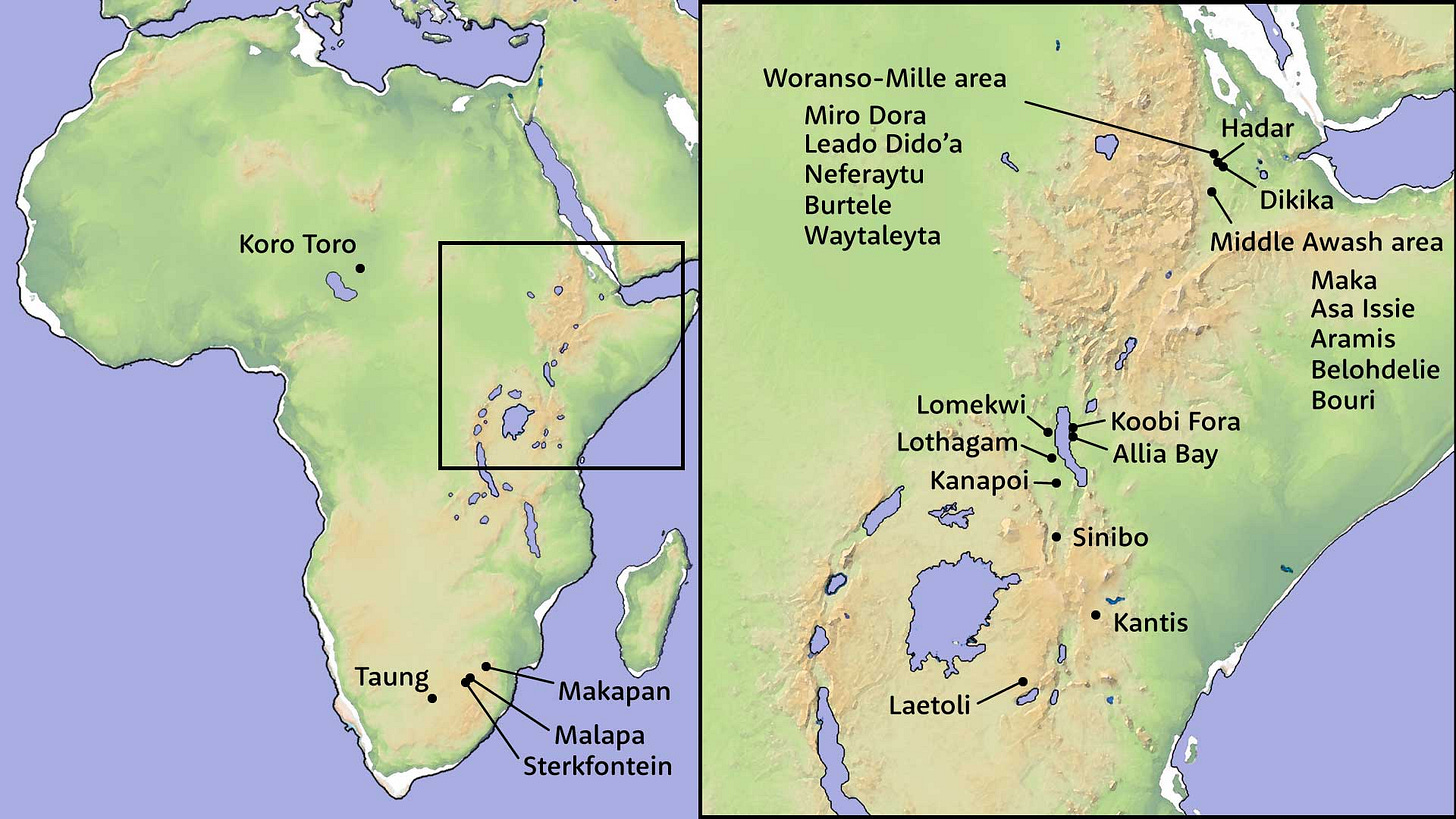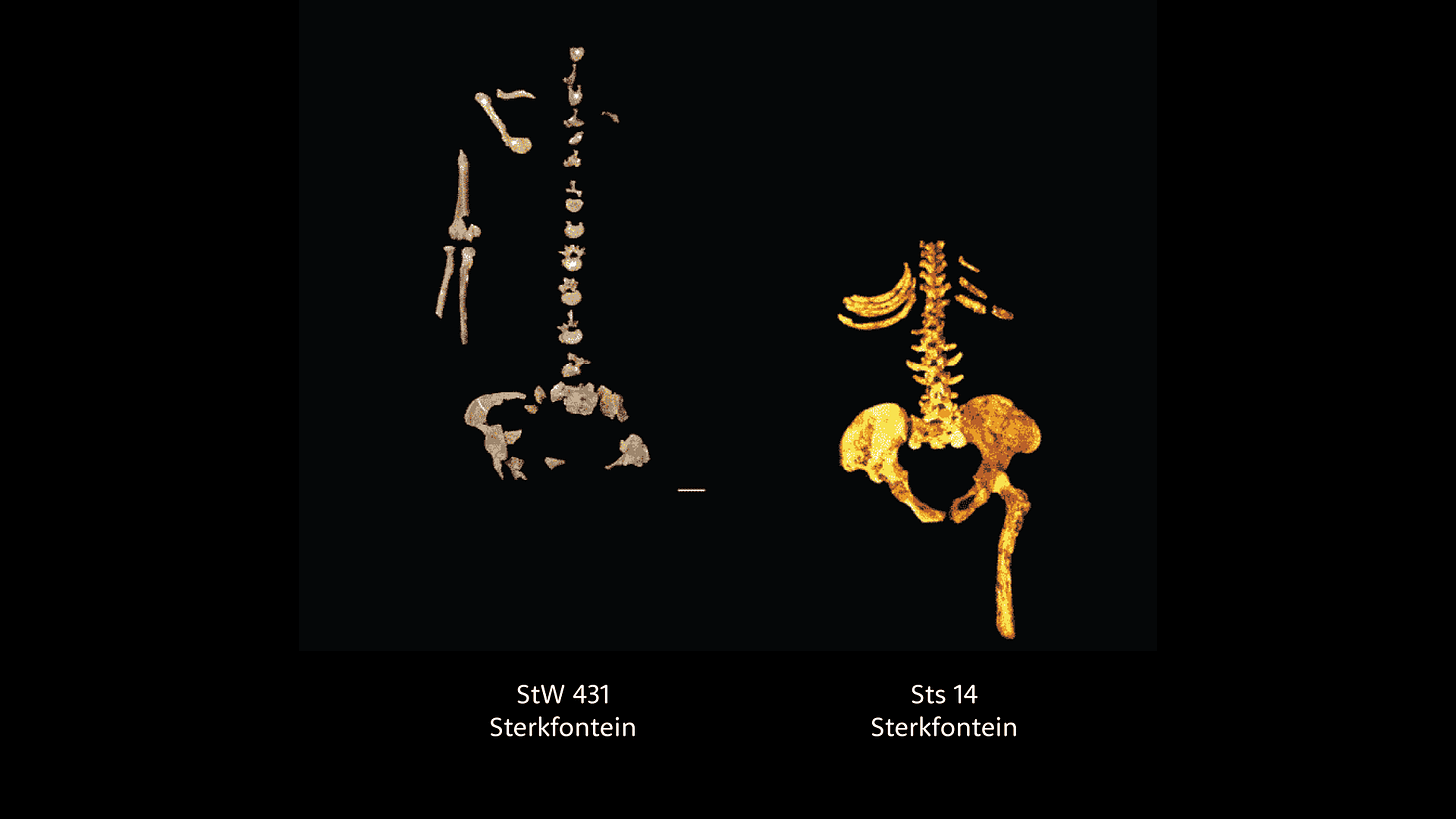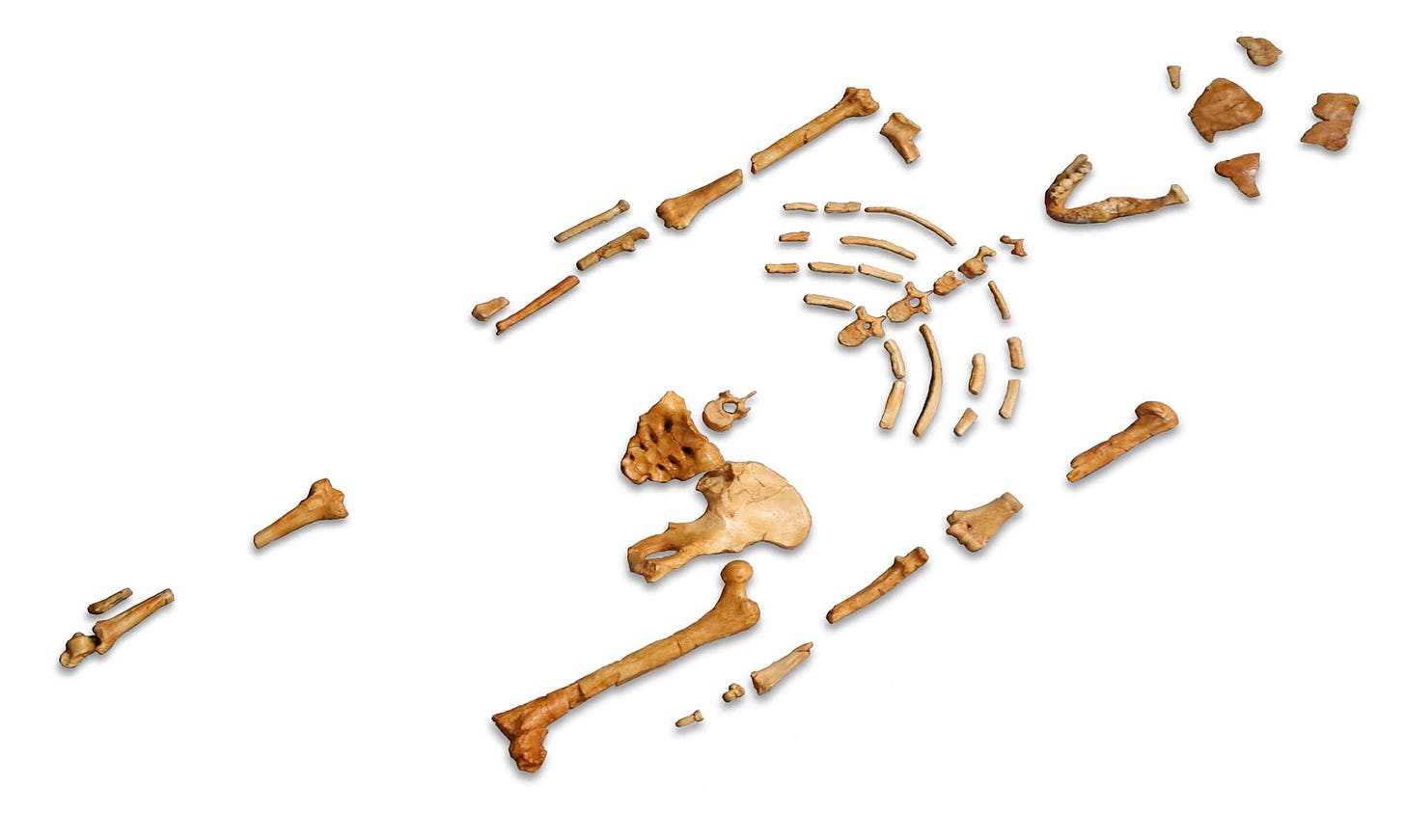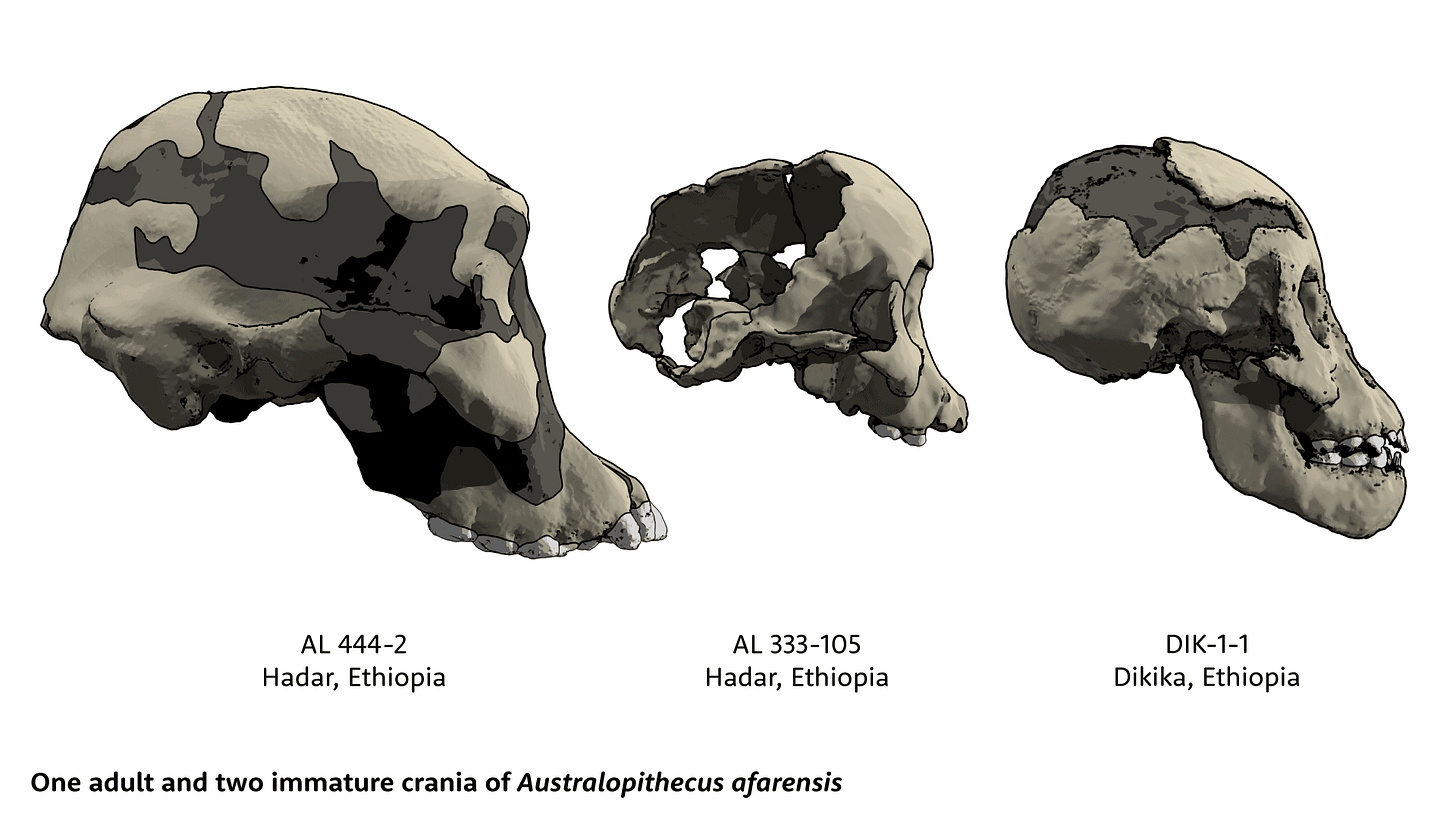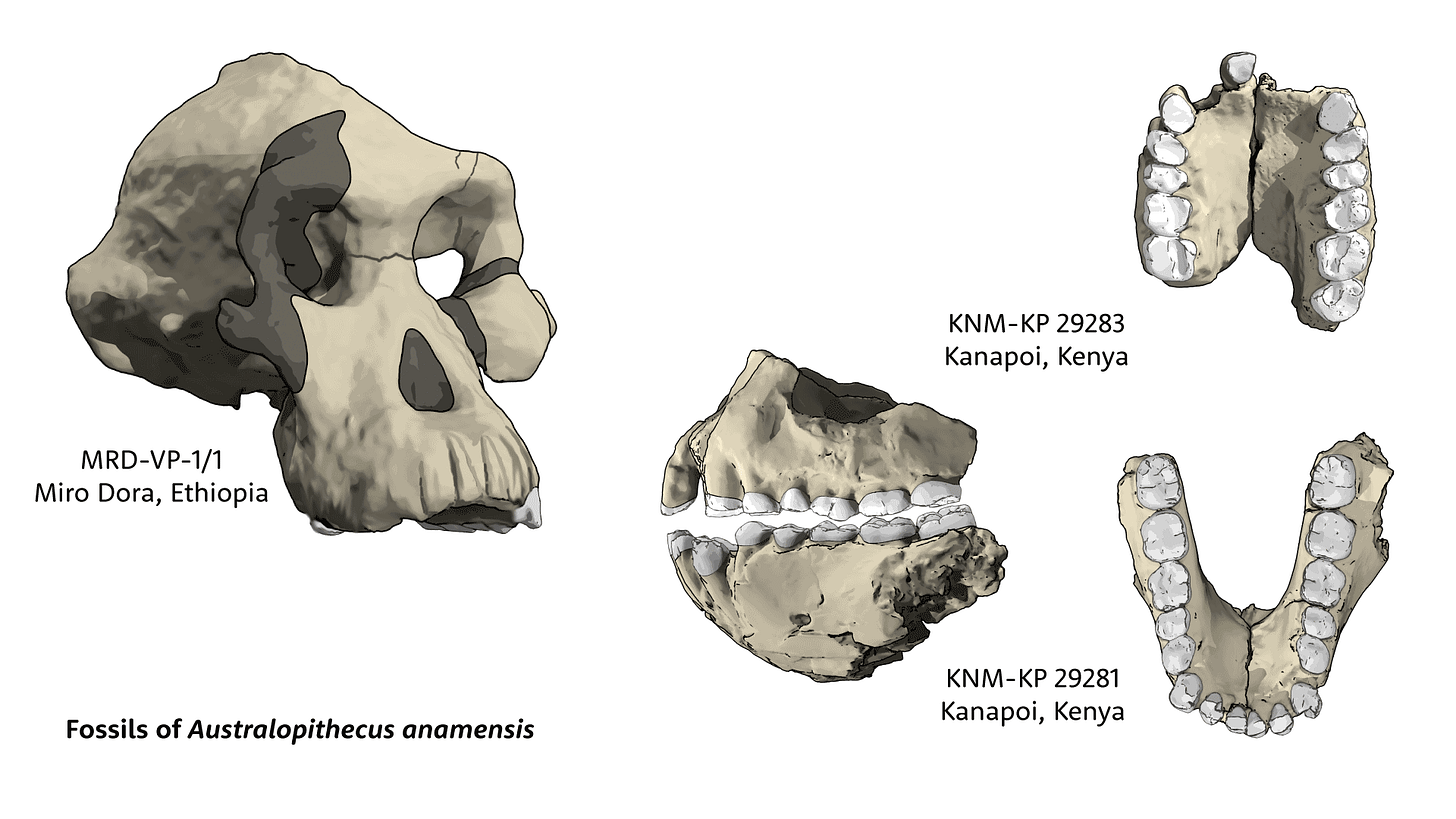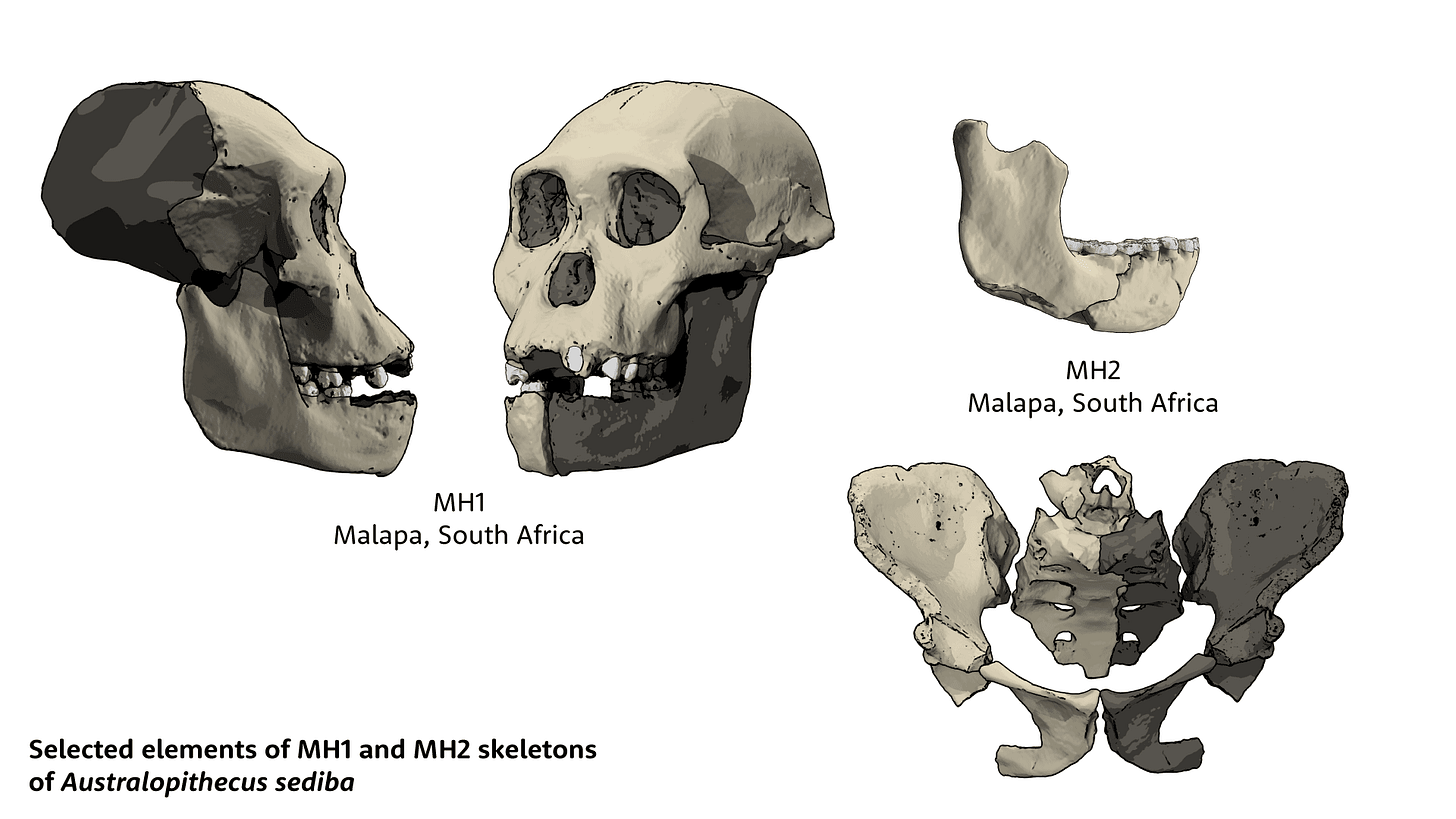Guide to Australopithecus species
These ancient human relatives include the first species with evidence of upright walking and running like humans. They represent more than a third of our evolutionary history.
The first fossil of Australopithecus became part of the science of human origins in 1925 when Raymond Dart described the fossil skull from Taung, South Africa. In the ninety-eight years since then, anthropologists have recovered hundreds of fossils of these early hominins, spanning from more than four million years ago until just around two million. That's roughly the middle third of the time since our ancestors first divided from the ancestors of chimpanzees and bonobos.
This post gives a quick overview of each species of Australopithecus that we know about today. Many scientists use a common name for these species: australopiths. In the human family tree, these species are close relatives of our own genus, Homo, and some may have been our ancestors. I'll include one species that is not Australopithecus but is a very close relative.
At the end, I'll consider the question so many people ask me about early hominins: Why does it seem like their names keep changing?
Relationships of Australopithecus
All australopiths shared the bipedal form of locomotion that today's humans rely upon. Their bodies had many features that reflect this adaptation to upright walking, from their feet, legs, and pelvis, to their spines and skulls. These features set them apart from early fossil relatives that were not bipedal, like Ardipithecus. Australopiths differ from our own genus, Homo, in other ways. They had bigger molar and premolar teeth than living humans, with thicker enamel. All had smaller brain sizes than humans, with average endocranial volumes between around 400 and 600 milliliters.
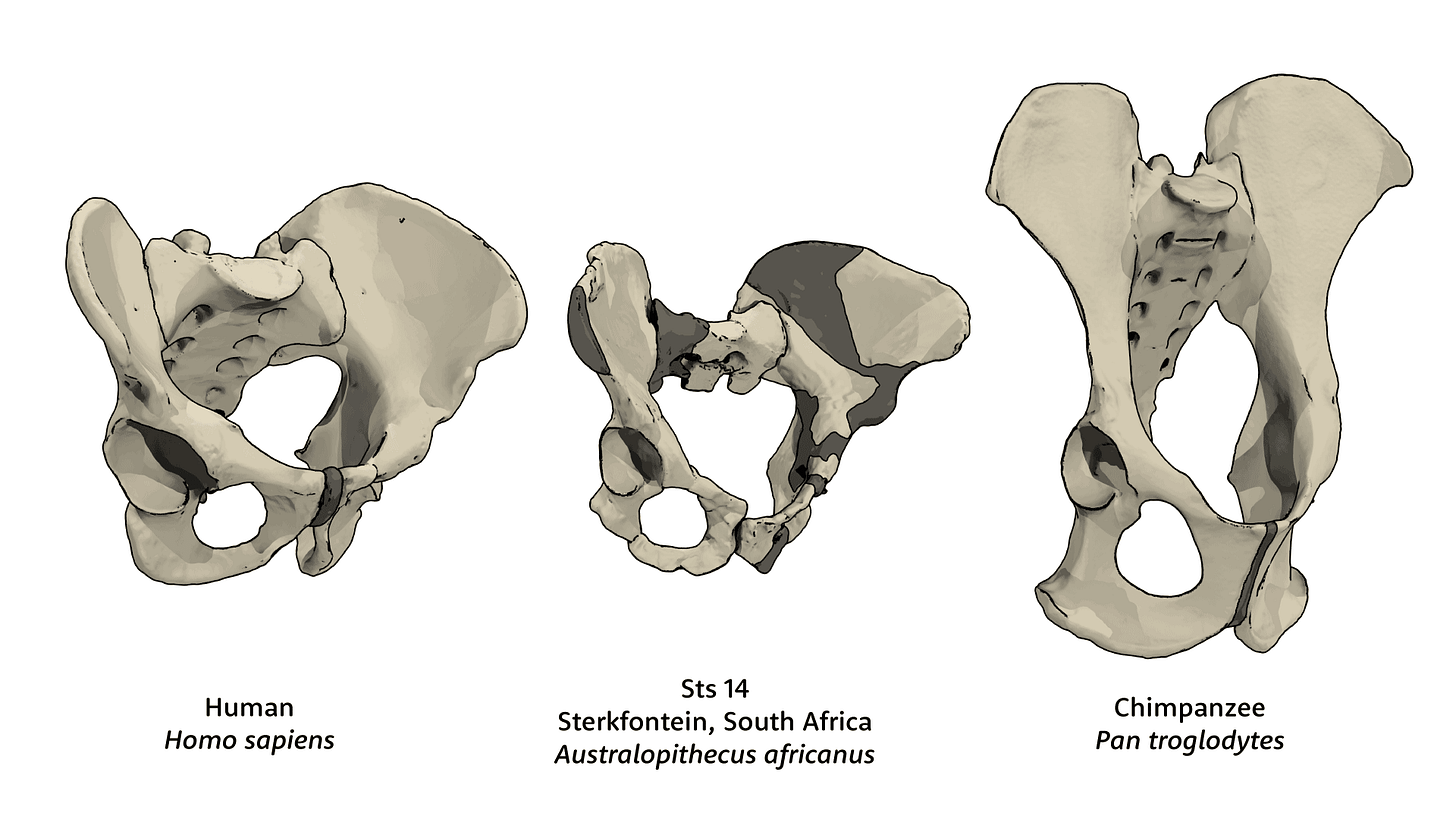
Scientists think that some form of australopith was the ancestor of Homo. The best information today suggests that the ancestral population of our genus first separated from australopiths before 2.8 million years ago. Another form of hominins, which scientists classify as Paranthropus, likewise separated from some australopith lineage before this time. These species, often known as “robust australopiths”, had bigger jaw muscles and mandibles as well as larger molar and premolar teeth than either Australopithecus or Homo.
Australopiths lived across a wide range of time and geographic location. The earliest of these species, Australopithecus anamensis, is represented by fossils as early as 4.17 million years ago. The latest, Australopithecus sediba, lived just under 2 million years ago. Anthropologists have found australopith fossils in many parts of Africa. Some lived in very wooded landscapes and others in more grassland habitats.
Scientists know a lot more about two Australopithecus species than they know about the others. Australopithecus africanus and Australopithecus afarensis are both represented by hundreds of fossils from multiple sites, in each case extending across a substantial period of time. These fossil samples have biases. Teeth are more often preserved than bones, and scientists recognize parts of jaws and skulls more often than other parts of the body. Even so, scientists have found many postcranial remains of these species, including some partial skeletons that help show how different parts of their bodies evolved. Both adult and young individuals have been found, providing valuable evidence about how each species grew and developed.
About other kinds of Australopithecus we have less evidence. For some, like Australopithecus sediba, fossil skeletons provide strong evidence about their anatomy, but from only a single time and place. For others, like Australopithecus bahrelghazali or Australopithecus deyiremeda, only a few fossils provide much evidence about them. These fossils help to add breadth to our knowledge of the diversity of hominins, but we can't yet say as much about their adaptations or ways of life.
Australopithecus africanus
First appearance: As early as 3.7 million years, Sterkfontein, South Africa
Last appearance: Possibly less than 2.3 million years, Sterkfontein, South Africa
Holotype: Taung fossil cranium, Taung, South Africa
Named by: Raymond Dart, who described the Taung fossil skull in 1925. Other names were once applied to some of the fossils that scientists now attribute to this species, most notably Plesianthropus transvaalensis as named by Robert Broom in 1936.
Etymology: Australis is Latin for “southern”, pithekos is Greek for “ape” or “monkey”. The full name Australopithecus africanus is “southern ape from Africa”.
At the time the Taung skull was discovered, no fossil relatives of humans were known to be so much like living great apes in their brain size or facial anatomy. Further discoveries by Robert Broom started at Sterkfontein Caves in 1936, eventually revealing the anatomy of Au. africanus across much of its body. The species combines a very apelike brain size with large molar and premolar teeth, and a humanlike pelvis, spine, and lower limb. By the 1950s, these discoveries had established a basic scientific picture of Australopithecus.
The known sites of Au. africanus are all in South Africa: Sterkfontein Caves, Makapan Limeworks, and Taung. Sterkfontein has produced the largest number of fossils, more than 600 over the years, and over the last decade scientists have developed two different ideas about the age of these fossils, diverging by more than a million years from each other. Remains of Australopithecus mostly come from two geological units, the earlier Member 2 and later Member 4. The most recent work at the site suggests an age up to 3.7 million years for Member 2 and 3.5 million for Member 4. Those are older than estimates from previous analyses of the site, which had suggested that the Member 4 fossils are between 2.6 and 2.1 million years old. Today this is an open scientific question and both older and younger estimates have some evidence to support them. This uncertainty about the date of the fossils does not change their biological relationship to humans or other hominin species, which scientists interpret from their anatomy and not their age. Still, an accurate knowledge of the date means a lot for understanding the initial dispersal of hominins into southern Africa.
The last decade has seen a resurgence of scientific work on Au. africanus. Researchers have uncovered some details about the early childhood development of this species, finding that mothers provided mostly breastmilk to their infants for the first year but not long afterward—a timing that resembles some human societies but not living great apes. High-resolution scans of the internal structure of bones has shown how Au. africanus hand bones may reflect their use of tools. Such studies are leveraging a century of knowledge and new technology to help us understand the lives of these early hominins.
Australopithecus afarensis
First appearance: 3.9 million years, Belohdelie, Ethiopia
Last appearance: 3.0 million years, Hadar, Ethiopia
Holotype: LH 4 fossil mandible, Laetoli, Tanzania
Named by: Donald Johanson and coworkers in 1978. The name they gave, Australopithecus afarensis, is still used by most anthropologists. However, some use the name Praeanthropus afarensis, which recognizes that the species cannot be on the same branch as Australopithecus africanus without also including the genus Homo.
Etymology: The Afar region of Ethiopia is the homeland of the Afar people and language, afarensis means “from Afar”.
Australopithecus afarensis is the first human relative that many people think of today, and the fame of the “Lucy” skeleton is a big reason why. This individual is widely known in Ethiopia as “Dinkenesh”, which in the Amharic language means “you are beautiful”. Anthropologists know the skeleton by the number AL 288-1, and the individual lived around 3.18 million years ago. Like some other adult individuals of Au. afarensis, the AL 288-1 individual was quite small compared to living people, only around 1.2 meters in height and 28 kg in mass. Some other adult individuals were closer to the average body size of recent humans. For example, the KSD-VP-1/1 skeleton from the Korsi Dora 1 locality, Ethiopia, represents an individual of around 50 kg and 1.6 meters in height.
All of them walked bipedally. Their locomotion is attested abundantly by their skeletons and also by the 3.6-million-year-old footprint trails at Laetoli, Tanzania.
Australopithecus afarensis includes some exceptional fossil samples. The AL 333 locality, part of the Hadar field survey region in Ethiopia, is a place where anthropologists found more than 250 fossil fragments from at least 17 individuals. Something happened to these individuals that lived around 3.2 million years ago, burying remains of young and old alike in one small area. Another exceptional fossil is a child's skeleton from Dikika, Ethiopia, discovered by a team led by Zeresenay Alemseged. More fragmentary remains have been found at more than a dozen sites, including Laetoli in Tanzania, Kantis and Sinibo in Kenya, and Maka, Neferaytu, and Leado Dido'a in Ethiopia.
For the first thirty years after its discovery, scientists tended to see Au. afarensis as a direct ancestor of humans, and other species—like Au. africanus—as extinct side branches of the hominin tree. Today researchers pursue a greater diversity of approaches to these fossils. Yohannes Haile-Selassie has emphasized that other species including Australopithecus deyiremeda lived during the same time range in the region of Ethiopia where Au. afarensis is known best. How such different populations may have interacted, or whether they represent recurrent invasion of the region by hominins with more continuous habitation elsewhere, is not yet clear.
Australopithecus anamensis
First appearance: 4.17 million years, Kanapoi, Kenya
Last appearance: 3.8 million years, Miro Dora, Ethiopia
Holotype: KNM-KP 29281 mandible from Kanapoi, Kenya
Named by: Meave Leakey and coworkers in 1995
Etymology: anam is a word from the Turkana language that means “lake”; anamensis means “from the lake”.
Most anthropologists agree that Au. anamensis is very much like Au. afarensis. The key differences between the two species are in the shape of the jaw and teeth: Au. anamensis had long and more parallel alignments of the premolars and molars, with a more sloping symphysis and more procumbent incisors. The two overlap in the form and size of most teeth, although Au. afarensis more often had canine and premolar form that prevented cutting wear between the two. Both species lived in Ethiopia and Kenya, although the earlier Au. anamensis has not yet been found south of the Turkana Basin. For the first twenty-five years after the recognition of Au. anamensis, most researchers supported the idea that the two species are earlier and later parts of a single lineage.
That idea has shifted somewhat in the last few years. Yohannes Haile-Selassie and coworkers described the MRD-VP-1/1 partial skull from Miro Dora, Ethiopia, in 2019. This established that Au. anamensis may have persisted a bit later than the first Au. afarensis. The known samples of these two species differ in their carbon stable isotopes, with Au. afarensis depending more on warm-season grasses, and they may have survived best in different habitats. The possibility that South African Au. africanus fossils may be earlier than once thought provokes the question of whether Au. anamensis or early Au. afarensis may be the ancestor of this species.
Kenyanthropus platyops
First appearance: 3.50 million years, Lomekwi, Kenya.
Last appearance: 3.03 million years, Lomekwi, Kenya.
Holotype: KNM-WT 40000 partial skull, from Lomekwi, Kenya.
Named by: Meave Leakey and coworkers in 2001
Etymology: Kenyanthropus honors the nation of Kenya; platyops is Greek for “flat face”.
All fossils so far attributed to Kenyanthropus platyops come from the western part of the Turkana Basin, in deposits that formed from 3.5 million to 3 million years ago. The much-better-known species that lived at this same time is Au. afarensis, which researchers have found in Tanzania, southern Kenya, and Ethiopia. Australopithecus africanus may also have been a contemporary, much further to the south. In its skull and teeth, K. platyops does differ from these species in several ways. Its teeth are a bit smaller on average, the lower part of its face is flatter and less projecting, and it has a smaller ear opening, along with other slight differences.
Meave Leakey and collaborators broke a longstanding trend by placing this fossil species into a new genus instead of Australopithecus. Their analysis of K. platyops suggested that this species might be a close relative of Homo. They especially noted similarities between the best-preserved K. platyops skull, KNM-WT 40000, and an early Homo fossil from around 2.1 million years ago, KNM-ER 1470.
Still, the fossil record of K. platyops leaves open most questions about its relationships. The KNM-WT 40000 skull was crushed as it fossilized, impeding comparisons with known samples of Australopithecus. Also, researchers have not yet reported any postcranial fossils of this species. Some anthropologists think that K. platyops may have been a regional population of Au. afarensis.
While anthropologists may have divergent opinions about the connection of the Lomekwi fossil samples to other hominins, the Lomekwi region is very important to archaeologists also. Here, around 3.3 million years ago, someone made the first-known stone tools. At present, only K. platyops fossils are known from this interval anywhere in the Turkana Basin. Understanding how the populations of this region were connected to others across Africa is a high priority for fossil exploration.
Australopithecus bahrelghazali
Only appearance: 3.58 ± 0.27 million years, Koro Toro, Chad.
Holotype: KT 12/H1 mandible, from Koro Toro locality 12, near the shore of the former mega-Lake Chad.
Named by: Michel Brunet and coworkers in 1995
Etymology: Bahr el Ghazal is the name of the region of Chad where the fossils were found.
Paleontologists have worked hard to find Pliocene fossil deposits in the Rift Valley of eastern Africa and the cave systems of South Africa. Another area with Pliocene fossils is central Chad, where the basin that now contains Lake Chad has fossil deposits on the ancient shorelines that mark its much larger Pliocene extent. The 3.5-million-year-old deposits near Koro Toro have produced pieces of three fossil hominin individuals, which Michel Brunet and coworkers attributed to Australopithecus bahrelghazali.
The most substantial fossil is the KT 12/H1 mandibular fragment. Brunet and coworkers observed some subtle differences between this fossil and those known for Au. afarensis at the time, including the more vertical posterior surface of the symphysis and its three-rooted premolars. As in the case of K. platyops, some researchers have suggested that the Koro Toro fossils may represent a regional variation of Au. afarensis.
Australopithecus deyiremeda
First appearance: ~3.5 million years, Burtele collection area 3, Ethiopia
Last appearance: ~3.3 million years, Waytaleyta collection area 2, Ethiopia
Holotype: BRT-VP-3/1 maxillary fragment
Named by: Yohannes Haile-Selassie and coworkers in 2015
Etymology: The name comes from the Afar language; deyi means “close” and remeda means “relative”.

This species was identified by Yohannes Haile-Selassie and coworkers based on their work in the Woranso-Mille area, around 40 km north of the Afar River and sites including Hadar and Dikika. Both the upper and lower jaw of Au. deyiremeda are shaped in ways that would have positioned the masseter muscles of the jaw were further toward the front of the face, with the zygomatic process of the maxilla and mandibular ramus both further forward than in Au. afarensis. The sizes of the molar and premolar teeth are relatively small, and the upper canine is small and simple compared to Au. afarensis also. None of the rest of the skeleton of this species is known.
The Woranso-Mille region has several sites with Au. afarensis fossils, and if Au. deyiremeda had a different evolutionary history from Au. afarensis, the two species would likely have been in contact with each other. This may be the earliest evidence that two hominin species lived in the same area at the same time. With so little information from Au. deyiremeda, it's not clear whether the two species differed in diet or habitat preferences. One possibility is that one or both species first evolved elsewhere and later came into contact. If this region was a contact zone between two hominin species, there may be signs that some fossils come from populations with hybrid ancestry.
Australopithecus prometheus
First appearance: 3.7 million years, Sterkfontein, South Africa
Last appearance: 2.6 million years, Makapan Limeworks, South Africa
Holotype: MLD 1 cranial fragment
Named by: Raymond Dart in 1948
Etymology: In Greek myth, Prometheus was a character who first brought knowledge of fire to humanity.
Anatomy students at the University of the Witwatersrand, including Phillip Tobias, prospected the breccia dumps from the Makapan Limeworks after the Second World War, finding many fossils. Dart studied these fossils and came to the point of view that hominins had been responsible for many broken and blackened animal bones, prompting the idea that these ancient human relatives may have used fire. His name, Australopithecus prometheus, reflects that hypothesis. Later scientists showed that the color of the fossils was caused by mineral staining after they were deposited in the cave, and their breakage cannot be attributed to hominin activity.
Dart recognized many similarities between the Makapan fossils and those from Sterkfontein and Taung, but he judged that the MLD 1 cranial fragment represented a larger brain size, and so he separated it as Au. prometheus. John Robinson later argued that these three samples of hominin fossils all represent a single form, which he recognized as Au. africanus. Most anthropologists since the late 1950s have followed this idea. However, not all scientists today accept that the Sterkfontein Australopithecus fossils all are one species. The analysis of the StW 573 skeleton by Ronald Clarke and many coworkers led them to hypothesize that this individual is connected with MLD 1 and some other Makapan and Sterkfontein fossils as Australopithecus prometheus. In their description, the evidence for larger tooth size, larger jaw musculature, and larger brain size, together with other features of the face and skull, really do set the Au. prometheus fossils apart from Au. africanus.
I have written that I think Dart's definition of Au. prometheus no longer can stand up today. Still, the StW 573 skeleton provides a great deal of information that helps to put the Sterkfontein and Makapansgat variation into better context. I would not be surprised if some of the variation of these fossil samples represents closely related species, or mixture of populations. The competing ideas of geologists about the formation of the Sterkfontein deposits is a big challenge for interpreting this variation. The earliest estimate of the geological age of the StW 573 skeleton is 3.7 million years, but some scientists have proposed it may be less than 2.3 million. That's a big uncertainty. Understanding whether the fossils actually come from widely separated times makes a difference to interpreting their variation.
Australopithecus garhi
Only appearance: 2.5 million years, Bouri, Ethiopia.
Holotype: BOU-VP-12/130, a fragmentary cranium from Bouri, in the Middle Awash field survey region of Ethiopia.
Named by: Berhane Asfaw and coworkers in 1999
Etymology: In the Afar language, the word garhi means “surprise”.
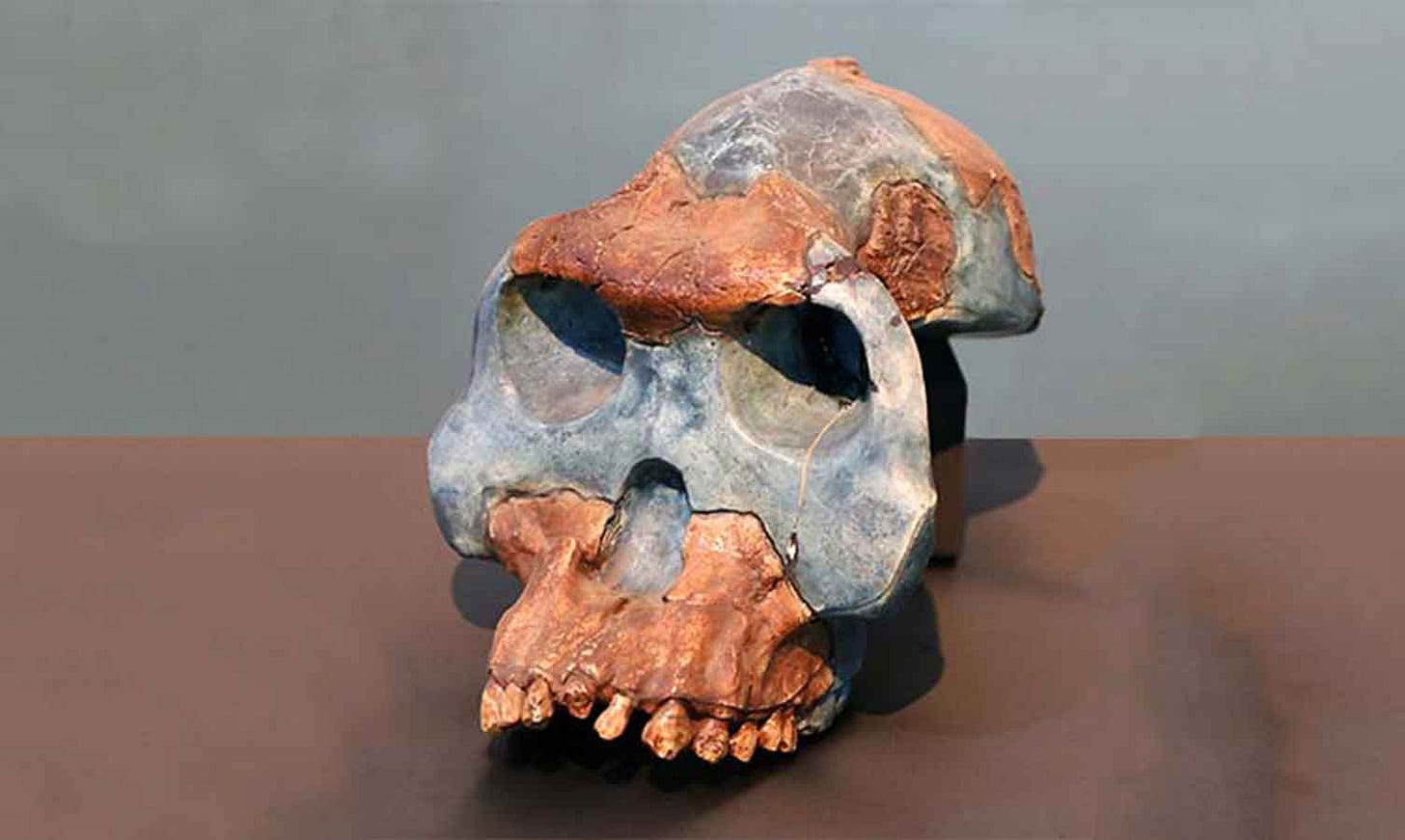
In the context of 1999, the BOU-VP-12/130 skull looked very different from other hominins known in Ethiopia. The massive premolars of this skull compare to Paranthropus, while the large canine size stood out from all other Australopithecus species. From today's perspective, very large Au. afarensis crania, especially the AL 444-2 skull, have a shape a lot like what is preserved in this skull. Some aspects of the skull's anatomy are similar to samples from other species, particularly Au. africanus which lived around the same time in South Africa.
No other parts of the individual represented by the BOU-VP-12/130 skull are known, which makes it difficult to assess whether other hominin fossils also may belong to Au. garhi. A few hominin fossils from roughly the same time are known from other localities near Bouri, including a mandible and a partial skeleton.
A number of animal bones with cutmarks were identified at the same fossil locality where the Au. garhi holotype skull was found. The association suggested that Au. garhi may have made stone tools and relied on meat and marrow. An early form of Homo may be present in the region as much as 300,000 years earlier than the Au. garhi skull, and without more fossils to assess their distribution or possible relationship, it's hard to say where Au. garhi may fit in.
Australopithecus sediba
Only appearance: 1.98 million years, Malapa, South Africa.
Holotype: MH1 fossil skeleton, Malapa, South Africa.
Named by: Lee Berger and coworkers in 2010
Etymology: The word sediba means “fountain” or “spring” in the Sesotho language commonly spoken in the region of South Africa that includes the Malapa site.
Australopithecus sediba is known from two partial skeletons and a few fossils attributable to other individuals, all from Malapa, South Africa. The MH1 skeleton belonged to a child of between seven and nine years of age, and MH2 was an adult with strongly worn teeth, inferred to be a female individual based on its small tooth dimensions and body size compared to the MH1 juvenile. The fossils are similar to earlier species of Australopithecus in many aspects of their anatomy. The MH1 individual had a small brain size, both skeletons came from individuals similar in size to Au. africanus fossils, and both had relatively long arms and short legs like Au. africanus.
At the same time Au. sediba differs from other fossils of Australopithecus in ways that align the species with early Homo fossils. The individuals have smaller molars and premolars than other Australopithecus species and thinner mandibles. They have less flaring pelves, and the anatomy of the MH2 wrist and hand shows humanlike features that not evident in other known Australopithecus fossils. These kinds of observations suggest that Au. sediba had common ancestors with Homo more recently than other Australopithecus species.
Names of fossil species
Anytime I discuss so many species names, it brings up the old debate about lumping versus splitting in recognizing fossil species. How do scientists decide which fossils represent new species and which ones belong to already-known species?
The longer I study fossil hominins, the more I understand Charles Darwin's perspective on species. Darwin wrote:
“In determining whether a form should be ranked as a species or a variety, the opinion of naturalists having sound judgment and wide experience seems the only guide to follow.”—Charles Darwin
What marked the differences between species, for Darwin, was that they could be clearly distinguished from each other; they don't grade continuously from one into another. Fossils don't often give us the kind of evidence that lets us test whether they belonged to groups with boundaries between them. Some fossil samples cover a long period of time during which species evolved.
Ideas about fossil species are subject to scientific testing. With more evidence, scientists change their ideas about fossil groups. Part of systematics is revising old definitions and sometimes discarding species names entirely. Some species names on this list may not last. Maybe we will find that Australopithecus garhi really was a regional population of Au. africanus, or that Kenyanthropus platyops and Au. deyiremeda were closer than we now think. Some may join the list of names that scientists don't use any more, like Plesianthropus transvaalensis.
Genus names may change for another reason. For a long time from the 1960s to the 2000s, many anthropologists saw Australopithecus as a catch-all for every kind of early human relative that was not part of our own genus, Homo. In that era, biologists defined a genus to be a group of species that are close relatives and share a similar pattern of adaptation to their environments. All the hominins that were known at that time walked bipedally like humans, but early hominins had much smaller brains than humans today. Anthropologists saw two simple categories: Later, larger-brained hominins were Homo and earlier hominins with smaller brain size were Australopithecus.
Over the past thirty years scientific ideas about classification have changed in a crucial way. Today biologists try to make sure that all the species that share a common ancestor are included within a group. Applied to the family level, this concept has made a big difference to the way we classify living great apes. Before the 1980s, most systematists accepted living chimpanzees, gorillas, and orangutans as a single family, called Pongidae, and humans as a separate family, Hominidae. This recognized the many differences in body form and behavior in humans compared to those great apes. But we now recognize that humans are closer to chimpanzees and bonobos than to orangutans, and classify the great apes and humans as Hominidae. They are in the same family because they all share the same ancestor, despite their differences in body and behavior.
Taking this principle to the genus level in fossil hominins has consequences for Australopithecus. Under our current best evidence, almost all researchers agree that some of the species of Australopithecus are closer relatives of Homo than others. If we classify them by their place on the tree, and not just the size of their brain, then some of their names must change. The name Australopithecus must stick with Au. africanus. Biologists may need different genus names for some others.
This has caused anthropologists to revive some older genus names for some species. Species of “robust australopiths”, in the 1970s commonly accepted as Australopithecus, are now usually classified within their own genus, Paranthropus. Another name, Praeanthropus, is an earlier genus name attributed to Australopithecus afarensis that has returned in some anthropologists' work. And in 2001, Meave Leakey and collaborators recognized that new names may be necessary when they defined Kenyanthropus. It is likely that scientists will continue to add new names.
Nonetheless, our knowledge of relationships among fossil species is still shifting with each new discovery. With living primates we have whole genomes, but our knowledge of relationships of early hominins depends on the quality of the fossils. For the time being, many anthropologists are content to clump many similar species within Australopithecus without worrying too much about whether the names are a perfect fit to the branches of today's tree.
Notes: I've given “first appearance” and “last appearance” dates where possible, and this raises a possible confusion since both may have ranges of error or uncertainty. I've generally chosen to make these the modal date for the earliest or latest fossil attributed to the species, reported by the most recent research study. But that date may be a long time away from the earliest possible or latest possible dates. For Sterkfontein, where more than a million years of time are involved, I discuss this issue in some detail. For other sites, uncertainty of tens of thousands of years may apply.
The 2023 work by Mongle and coworkers gives a current perspective on the phylogeny of these species and my tree diagram relies on this study. They did not include Au. bahrelghazali or Au. deyiremeda due to the low representation of anatomy in these species. It seemed logical to include Au. bahrelghazali from a node that includes Au. afarensis, so I added it. The placement of Au. deyiremeda is less intuitive to me, whether the features it shares with Homo are the same or different as those found in Kenyanthropus or Au. sediba matters a lot, and more study will be required. So I didn't place this species in the tree.
I've included references below that give the first diagnosis of each species. To a more limited degree, I include references to current information about the age of key fossils, although this would quickly become a very long list. Articles by Granger and coworkers and by Pickering and Herries provide alternative points of view regarding the age of Sterkfontein fossils. For readers who would like more information about the names of fossil hominins, I can recommend the article by Denné Reed and coworkers, who have compiled a list of more than 200 names that scientists have defined for hominins, and they provide information about how the rules of taxonomy apply to these.
References:
Asfaw, B., White, T., Lovejoy, O., Latimer, B., Simpson, S., & Suwa, G. (1999). Australopithecus garhi: A New Species of Early Hominid from Ethiopia. Science, 284(5414), 629–635. https://doi.org/10.1126/science.284.5414.629
Berger, L. R., de Ruiter, D. J., Churchill, S. E., Schmid, P., Carlson, K. J., Dirks, P. H. G. M., & Kibii, J. M. (2010). Australopithecus sediba: A New Species of Homo-Like Australopith from South Africa. Science, 328(5975), 195–204. https://doi.org/10.1126/science.1184944
Broom, R. (1938). The Pleistocene Anthropoid Apes of South Africa. Nature, 142(3591), Article 3591. https://doi.org/10.1038/142377a0
Brunet, M., Beauvilain, A., Coppens, Y., Heintz, E., Moutaye, A. H. E., & Pilbeam, D. (1995). The first australopithecine 2,500 kilometres west of the Rift Valley (Chad). Nature, 378(6554), Article 6554. https://doi.org/10.1038/378273a0
Brunet, M., Beauvilain, A., Coppens, Y., Heintz, E., Moutaye, A. H. E., & Pilbeam, D. (1996). Australopithecus bahrelghazali, une nouvelle espèce d’Hominidé ancien de la région de Koro Toro (Tchad). Australopithecus Bahrelghazali, Une Nouvelle Espèce d’Hominidé Ancien de La Région de Koro Toro (Tchad), 322(10), 907–913.
Clarke, R. J., & Kuman, K. (2019). The skull of StW 573, a 3.67 Ma Australopithecus prometheus skeleton from Sterkfontein Caves, South Africa. Journal of Human Evolution, 134, 102634. https://doi.org/10.1016/j.jhevol.2019.06.005
Dart, R. A. (1925). Australopithecus africanus the man-ape of South Africa. Nature, 115(2884), Article 2884. https://doi.org/10.1038/115195a0
Dart, R. A. (1948). The Makapansgat proto-human Australopithecus prometheus. American Journal of Physical Anthropology, 6(3), 259–284. https://doi.org/10.1002/ajpa.1330060304
Granger, D. E., Gibbon, R. J., Kuman, K., Clarke, R. J., Bruxelles, L., & Caffee, M. W. (2015). New cosmogenic burial ages for Sterkfontein Member 2 Australopithecus and Member 5 Oldowan. Nature, 522(7554), Article 7554. https://doi.org/10.1038/nature14268
Granger, D. E., Stratford, D., Bruxelles, L., Gibbon, R. J., Clarke, R. J., & Kuman, K. (2022). Cosmogenic nuclide dating of Australopithecus at Sterkfontein, South Africa. Proceedings of the National Academy of Sciences, 119(27), e2123516119. https://doi.org/10.1073/pnas.2123516119
Haile-Selassie, Y. (2010). Phylogeny of early Australopithecus: New fossil evidence from the Woranso-Mille (central Afar, Ethiopia). Philosophical Transactions of the Royal Society B: Biological Sciences, 365(1556), 3323–3331. https://doi.org/10.1098/rstb.2010.0064
Haile-Selassie, Y., Gibert, L., Melillo, S. M., Ryan, T. M., Alene, M., Deino, A., Levin, N. E., Scott, G., & Saylor, B. Z. (2015). New species from Ethiopia further expands Middle Pliocene hominin diversity. Nature, 521(7553), Article 7553. https://doi.org/10.1038/nature14448
Berger, L. R., & Hawks, J. (2019). Australopithecus prometheus is a nomen nudum. American Journal of Physical Anthropology, 168(2), 383–387. https://doi.org/10.1002/ajpa.23743
Johanson, Donald C., White, Tim D., & Coppens, Yves. (1978). A new species of the genus Australopithecus (Primates: Hominidae) from the Pliocene of eastern Africa. Kirtlandia, 28, 1–14.Leakey, M. G., Feibel, C. S., McDougall, I., & Walker, A. (1995). New four-million-year-old hominid species from Kanapoi and Allia Bay, Kenya. Nature, 376(6541), Article 6541. https://doi.org/10.1038/376565a0
Leakey, M. G., Feibel, C. S., McDougall, I., Ward, C., & Walker, A. (1998). New specimens and confirmation of an early age for Australopithecus anamensis. Nature, 393(6680), Article 6680. https://doi.org/10.1038/29972
Leakey, M. G., Spoor, F., Brown, F. H., Gathogo, P. N., Kiarie, C., Leakey, L. N., & McDougall, I. (2001). New hominin genus from eastern Africa shows diverse middle Pliocene lineages. Nature, 410(6827), Article 6827. https://doi.org/10.1038/35068500
Lebatard, A.-E., Bourlès, D. L., Duringer, P., Jolivet, M., Braucher, R., Carcaillet, J., Schuster, M., Arnaud, N., Monié, P., Lihoreau, F., Likius, A., Mackaye, H. T., Vignaud, P., & Brunet, M. (2008). Cosmogenic nuclide dating of Sahelanthropus tchadensis and Australopithecus bahrelghazali: Mio-Pliocene hominids from Chad. Proceedings of the National Academy of Sciences, 105(9), 3226–3231. https://doi.org/10.1073/pnas.0708015105
Mbua, E., Kusaka, S., Kunimatsu, Y., Geraads, D., Sawada, Y., Brown, F. H., Sakai, T., Boisserie, J.-R., Saneyoshi, M., Omuombo, C., Muteti, S., Hirata, T., Hayashida, A., Iwano, H., Danhara, T., Bobe, R., Jicha, B., & Nakatsukasa, M. (2016). Kantis: A new Australopithecus site on the shoulders of the Rift Valley near Nairobi, Kenya. Journal of Human Evolution, 94, 28–44. https://doi.org/10.1016/j.jhevol.2016.01.006
Mongle, C. S., Strait, D. S., & Grine, F. E. (2023). An updated analysis of hominin phylogeny with an emphasis on re-evaluating the phylogenetic relationships of Australopithecus sediba. Journal of Human Evolution, 175, 103311. https://doi.org/10.1016/j.jhevol.2022.103311
Pickering, Robyn & Herries, Andy I. R. (n.d.). A new multidisciplinary age of 2.61–2.07 Ma for the Sterkfontein Member 4 australopiths. In Zipfel, Bernhard, Richmond, Brian, & Ward, Carol V. (Eds.), Hominin Postcranial Remains from Sterkfontein, South Africa, 1936-1995 (pp. 21–32). Oxford University Press.
Reed, D. N., Raney, E., Johnson, J., Jackson, H., Virabalin, N., & Mbonu, N. (2023). Hominin nomenclature and the importance of information systems for managing complexity in paleoanthropology. Journal of Human Evolution, 175, 103308. https://doi.org/10.1016/j.jhevol.2022.103308
Spoor, F., Leakey, M. G., & O’Higgins, P. (2016). Middle Pliocene hominin diversity: Australopithecus deyiremeda and Kenyanthropus platyops. Philosophical Transactions of the Royal Society B: Biological Sciences, 371(1698), 20150231. https://doi.org/10.1098/rstb.2015.0231
White, T. D., WoldeGabriel, G., Asfaw, B., Ambrose, S., Beyene, Y., Bernor, R. L., Boisserie, J.-R., Currie, B., Gilbert, H., Haile-Selassie, Y., Hart, W. K., Hlusko, L. J., Howell, F. C., Kono, R. T., Lehmann, T., Louchart, A., Lovejoy, C. O., Renne, P. R., Saegusa, H., … Suwa, G. (2006). Asa Issie, Aramis and the origin of Australopithecus. Nature, 440(7086), Article 7086. https://doi.org/10.1038/nature04629




